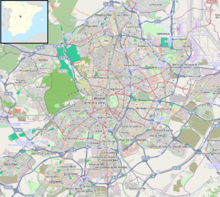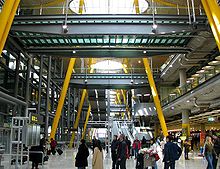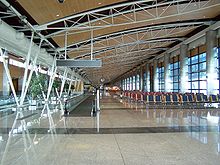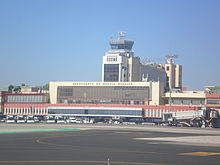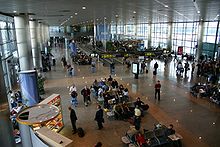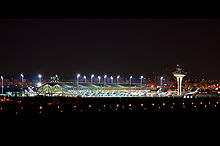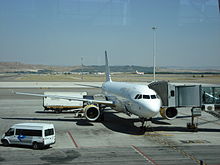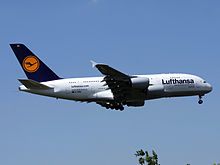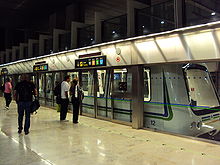- Madrid-Barajas Airport
-
Madrid-Barajas Airport
Aeropuerto de Madrid-Barajas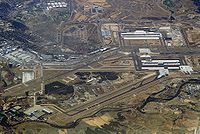
IATA: MAD – ICAO: LEMD Summary Airport type Public Operator Aena Serves Madrid, Spain Location Madrid, Alcobendas, San Sebastián de los Reyes and Paracuellos de Jarama, Spain Hub for Elevation AMSL 610 m / 2,000 ft Coordinates 40°28′20″N 003°33′39″W / 40.47222°N 3.56083°WCoordinates: 40°28′20″N 003°33′39″W / 40.47222°N 3.56083°W Website Map Location within Madrid Runways Direction Length Surface m ft 15R/33L 4,100 13,451 Asphalt 18L/36R 3,500 11,482 Asphalt 15L/33R 3,500 11,482 Asphalt 18R/36L 4,349 14,268 Asphalt / Concrete Statistics (2010) Passengers 49,863,504 Passenger change 09-10  2.9%
2.9%Aircraft Movements 433,683 Movements change 09-10  0.3%
0.3%Sources: Passenger Traffic, AENA[1]
Spanish AIP, AENA[2]Madrid-Barajas Airport (Spanish: Aeropuerto Internacional de Madrid-Barajas) (IATA: MAD, ICAO: LEMD)[3] is the main international airport serving Madrid in Spain. In 2010, over 49.8 million passengers used Madrid-Barajas,[1] making it the country's largest and busiest airport, and in 2009 it was the world's 11th busiest airport[4] and Europe's fourth busiest airport. It opened in 1928, and has grown to be one of the most important aviation centres of Europe. Located within the city limits of Madrid, just 9 km (5.6 mi) from the city's financial district and 13 km (8.1 mi) northeast of the Puerta del Sol, Madrid's historic centre. The airport name derives from the adjacent district of Barajas, which has its own metro station on the same rail line serving the airport.
The Madrid-Barcelona air shuttle service, known as the "Puente Aéreo" (in Spanish), literally "Air Bridge", was the busiest air route in Europe, with the highest number of flight operations (971 per week) before 2007.[5] The schedule has been reduced since February 2008, when the Madrid–Barcelona high-speed rail line was opened, covering the distance in 2½ hours, and quickly became popular. Barajas serves as the gateway to the Iberian peninsula from the rest of Europe and the world, and is a particularly key link between Europe and Latin America. The airport is the primary hub and maintenance base for Iberia. Consequently, Iberia is responsible for more than 60 percent of Barajas' traffic.
Contents
History
The airport was constructed in 1927, opening to national and international air traffic on 22 April 1931, although regular commercial operations began two years later. A small terminal was constructed with a capacity for 30,000 passengers a year, in addition to several hangars and the building of the Avión Club. The first regular flight was established by Lineas Aéreas Postales Españolas (LAPE) with its line to Barcelona. Later, in the 1930s international flights started to serve some European and African destinations.
Originally, the flight field was a large circle bordered in white with the name of Madrid in its interior, unpaved, consisting of land covered with natural grass. It was not until the 1940s that the flight field was paved and new runways were designed. The first runway which started operation in 1944 was 1,400 metres long and 45 metres wide. By the end of the decade the airport had three runways, none of which exists today. In the late 1940s, scheduled flights to Latin America and the Philippines started.
In the 1950s, the airport supported over half a million passengers, increasing to 5 runways and scheduled flights to New York City began. The National Terminal, currently T2, began construction in 1954, and was inaugurated later that year. In the Plan of Airports of 1957, Barajas Airport is classified as a first-class international airport. By the 1960s, large jets were landing at Barajas, and the growth of traffic mainly as a result of tourism exceeded forecasts. At the beginning of the decade, the airport reached the 1.2 million passengers, double that envisaged in the Plan of Airports of 1957.
In the 1970s, with the boom in tourism and the arrival of the Boeing 747, the airport reached 4 million passengers, and began the construction of the international terminal (current T1). In 1974, Iberia, L.A.E. introduced the shuttle service between Madrid and Barcelona, a service with multiple daily frequencies and available without prior reservation.
The 1982 FIFA World Cup brought significant expansion and modernisation of the airport's two existing terminals.
In the 1990s, the airport expanded further. In 1994, the first cargo terminal was constructed, and the control tower was renovated. In 1997, it opened the North Dock, which is used as an exclusive terminal for Iberia's Schengen flights. In 1998, it inaugurated a new control tower, 71 m tall, and then in 1999 the new South Dock opened, which implies an expansion of the international terminal. During this time, the distribution of the terminals changed: The south dock and most of the International Terminal were now called T1, the rest of the International Terminal and Domestic Terminal were now called T2 and the north dock was called T3.
In November 1998, the new runway 18R-36L started operations (replacing the previous 18–36), 4,400 m long, one of the largest in Europe under expansion plans called Major Barajas. In 2000, it began the construction of new terminals T4 and its satellite, T4S, designed by architects Antonio Lamela and Richard Rogers, and two parallel runways to the existing ones.
The new terminals and runways were completed in 2004, but administrative delays and equipment, as well as the controversy over the redeployment of terminals, delayed service until 5 February 2006.
In 2007, the airport processed more than 52 million passengers.
Barajas today
Terminal 4, designed by Antonio Lamela and Richard Rogers (winning team of the 2006 Stirling Prize), and TPS Engineers, (winning team of the 2006 IStructE Award for Commercial Structures)[6] was built by Ferrovial[7] and inaugurated on 5 February 2006. Terminal 4 is one of the world's largest airport terminals in terms of area, with 760,000 square meters (8,180,572 square feet) in separate landside and airside structures. It consists of a main building, T4 (470,000 m²), and a satellite building, T4S (290,000 m²), which are approximately 2.5 km apart. The new Terminal 4 is meant to give passengers a stress-free start to their journey. This is managed through careful use of illumination, with glass panes instead of walls, and numerous domes in the roof which allow natural light to pass through. With this new addition, Barajas is designed to handle 70 million passengers annually.
During the construction of Terminal 4, two more runways (15L/33R and 18L/36R) were constructed to aid in the flow of air traffic arriving and departing from Barajas. These runways were officially inaugurated on 5 February 2006 (together with the terminals), but had already been used on several occasions beforehand to test flight and air traffic manoeuvres. Thus, Barajas came to have four runways: two on a north-south axis and parallel to each other (separated by 1.8 km) and two on a northwest-southeast axis (and separated by 2.5 km). This allowed simultaneous takeoffs and landings into the airport, allowing 120 operations an hour (one takeoff or landing every 30 seconds).
Terminals 1, 2 and 3 are adjacent terminals that are home to SkyTeam and Star Alliance airlines, as well as Air Europa. Terminal 4 is home to Iberia, its franchise Air Nostrum and all Oneworld partner airlines. Gate numbers are continuous in terminals 1, 2 and 3 (A1 to E89), but are separately numbered in terminal 4.
Barajas was voted "Best Airport" in the 2008 Condé Nast Traveller Reader Awards.[8]
In December 2010, the Spanish government announced plans to tender Madrid-Barajas airport to companies in the private sector for a period of up to 40 years.[9]
Traffic and statistics
Passenger numbers
Passengers Aircraft Movements Cargo (tonnes) 2001 34,050,215 375,558 295,944 2002 33,915,302 368,029 295,711 2003 35,855,861 383,804 307,026 2004 38,718,614 401,503 341,177 2005 42,146,784 415,704 333,138 2006 45,799,983 434,959 325,702 2007 52,110,787 483,292 325,201 2008 50,846,494 469,746 329,187 2009 48,437,147 435,187 302,863 2010 49,863,504 433,683 373,380 Source: Aena Statistics[1] Route statistics
Busiest Domestic Routes from Madrid-Barajas (2010) Rank City Passengers Top Carriers 1  Barcelona, Catalonia
Barcelona, Catalonia3,106,678 Air Europa, Iberia, Spanair, Vueling Airlines 2  Palma de Mallorca, Balearic Islands
Palma de Mallorca, Balearic Islands1,694,854 Air Berlin, Air Europa, Iberia, Ryanair, Spanair 3  Gran Canaria, Canary Islands
Gran Canaria, Canary Islands1,561,475 Air Europa, Iberia, Ryanair, Spanair 4  Tenerife-North, Canary Islands
Tenerife-North, Canary Islands1,316,014 Air Europa, Iberia, Spanair 5  Valencia, Valencian Community
Valencia, Valencian Community1,023,681 Air Nostrum, Iberia, Ryanair, Spanair 6  Alicante, Valencian Community
Alicante, Valencian Community884,006 Iberia, Ryanair, Spanair 7  Bilbao, Basque Country
Bilbao, Basque Country837,966 Iberia, Spanair 8  Santiago de Compostela, Galicia
Santiago de Compostela, Galicia836,415 Air Europa, Iberia, Ryanair, Spanair 9  Vigo, Galicia
Vigo, Galicia663,285 Air Europa, Iberia 10  Málaga, Andalusia
Málaga, Andalusia618,505 Iberia, Spanair 11  Ibiza, Balearic Islands
Ibiza, Balearic Islands611,481 Air Europa, Air Nostrum, EasyJet, Spanair, Vueling Airlines 12  A Coruña, Galicia
A Coruña, Galicia609,758 Iberia, Spanair 13  Lanzarote, Canary Islands
Lanzarote, Canary Islands581,010 Air Europa, EasyJet, Iberia, Iberworld, Ryanair, Spanair 14  Asturias, Principality of Asturias
Asturias, Principality of Asturias560,267 Air Europa, Iberia 15  Jerez de la Frontera, Andalusia
Jerez de la Frontera, Andalusia449,107 Iberia, Ryanair 16  Tenerife-South, Canary Islands
Tenerife-South, Canary Islands403,938 Air Europa, Iberia, Ryanair, Spanair 17  Seville, Andalusia
Seville, Andalusia385,115 Iberia 18  Santander, Cantabria
Santander, Cantabria370,696 Air Nostrum, Ryanair 19  Fuerteventura, Canary Islands
Fuerteventura, Canary Islands366,229 Air Europa, EasyJet, Iberia, Iberworld, Spanair 20  Granada, Andalusia
Granada, Andalusia335,437 Iberia Airlines and destinations
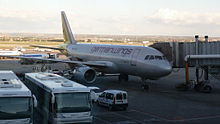 A Germanwings Airbus A319-100 parked at a gate
A Germanwings Airbus A319-100 parked at a gate Lufthansa's first Airbus A380 (D-AIMA) landing at Madrid-Barajas International Airport
Lufthansa's first Airbus A380 (D-AIMA) landing at Madrid-Barajas International Airport
Note: † denotes charter flights and their destinations
Airlines Destinations Terminal Aegean Airlines Athens 2 Aer Lingus Dublin, Washington-Dulles 1 Aeroflot Moscow-Sheremetyevo 1 Aerolíneas Argentinas Buenos Aires-Ezeiza 1 Aeroméxico Mexico City 1 Aerosur Santa Cruz de la Sierra 1 Air Algérie Algiers 4 Air Berlin Palma de Mallorca 2 Air Canada Toronto-Pearson 1 Air China Beijing-Capital, São Paulo-Guarulhos 1 Air Europa Arrecife, Buenos Aires-Ezeiza, Cancun, Caracas, Cartagena de Indias [begins 1 December], Dakar, Havana, Lima, London-Gatwick, Malabo, Mexico City, Miami, Puerto Plata, Punta Cana, Salvador da Bahia, Santo Domingo
Seasonal: New York-JFK1 Air Europa Amsterdam, Barcelona, Fuerteventura, Ibiza, Geneva [begins 25 March], Las Palmas de Gran Canaria, Lisbon, Milan-Malpensa, Minorca, Oviedo, Palma de Mallorca, Paris-Orly, Rome-Fiumicino, Santiago de Compostela, Tenerife-North, Tenerife-South, Venice, Vigo 2 Air France Paris-Charles de Gaulle 2 Air Mauritius Mauritius 1 Air India Mumbai, Delhi 1 Air Transat Montréal-Trudeau, Toronto-Pearson 1 AirBaltic Riga 2 Alitalia Milan-Linate, Rome-Fiumicino 2 American Airlines Dallas/Fort Worth, Miami, New York–JFK 4 Avianca Bogotá, Cali, Medellín 4 Blue Air Bucharest-Băneasa 1 British Airways London-Heathrow 4 British Airways operated by BA CityFlyer London-City 4 Brussels Airlines Brussels 2 Bulgaria Air Sofia 4 Conviasa Caracas 1 Cubana de Aviación Havana, Santiago de Cuba 1 Czech Airlines Prague 4 Delta Air Lines Atlanta, New York–JFK 1 EasyJet Amsterdam, Berlin-Brandenburg [begins 3 June 2012], Berlin-Schönefeld [ends 2 June 2012], Bordeaux, Bristol, Bucharest-Otopeni [ends 14 January], Casablanca, Edinburgh, Ibiza [resumes 15 June 2012], Lisbon, Liverpool, London-Gatwick, London-Luton, Lyon, Manchester, Marrakech, Milan-Malpensa, Minorca [resumes 25 June 2012], Naples, Paris-Charles de Gaulle, Rome-Fiumicino, Tangier, Toulouse, Venice-Marco Polo 1 EasyJet Switzerland Basel/Mulhouse, Geneva 1 EgyptAir Cairo 1 El Al Tel Aviv-Ben Gurion 4 Emirates Dubai 4 Finnair Helsinki 4 Freebird Airlines Seasonal: Istanbul-Ataturk 1 Iberia A Coruña, Algiers, Alicante, Amsterdam, Arrecife, Athens, Barcelona, Berlin-Tegel, Bilbao, Bogotá, Bologna, Boston, Brussels, Buenos Aires-Ezeiza, Cairo, Caracas, Casablanca, Chicago-O'Hare, Copenhagen, Córdoba [ends 20 January], Dakar, Düsseldorf, Frankfurt, Fuerteventura, Geneva, Genoa, Granada, Guatemala City, Guayaquil, Havana, Istanbul-Atatürk, Jerez de la Frontera, Johannesburg, Lagos, Las Palmas de Gran Canaria, Lima, Lisbon, London-Heathrow, Los Angeles, Luanda, Malabo, Malaga, Marrakech, Mexico City, Miami, Milan-Linate, Milan-Malpensa, Montevideo, Moscow-Domodedovo, Munich, New York–JFK, Oran, Oviedo, Palma de Mallorca, Panama City, Paris-Orly, Prague, Quito, Rio de Janeiro-Galeão, Rome-Fiumicino, San José de Costa Rica, San Juan, San Salvador, San Sebastián, Santa Cruz de la Palma, Santander, Santiago de Chile, Santiago de Compostela, Santo Domingo, São Paulo-Guarulhos, Seville, Stockholm-Arlanda, Tangier, Tel Aviv-Ben Gurion, Tenerife-North, Tenerife-South, Venice-Marco Polo, Vienna, Vigo, Zürich
Seasonal: Dubrovnik, Rabat, Saint Petersburg, Zagreb4 Iberia operated by Air Nostrum Almería, Athens, Badajoz, Bologna, Bordeaux, Dublin, Düsseldorf, Genoa, Glasgow-International, Granada, Ibiza, Jerez de la Frontera, Leon, Lisbon, Logroño, Lyon, Manchester, Marseille, Marrakech, Melilla, Milan-Malpensa, Minorca, Montpellier, Munich, Murcia, Nantes, Naples, Nice, Palma de Mallorca, Paris-Orly, Pamplona, Pisa, Porto, San Sebastián, Santander, Split [begins 21 July], Strasbourg, Tangier, Toulouse, Turin, Valencia, Vitoria, Zurich
Seasonal: A Coruña, Catania, Corfu, Heraklion, Malta, Olbia, Oviedo, Palermo, Rabat [begins 28 May 2012], Santa Cruz de la Palma, Santorini4 KLM Amsterdam 2 Korean Air Amsterdam, Seoul-Incheon 1 LAN Ecuador Guayaquil 4 LAN Perú Lima 4 LOT Polish Airlines Warsaw 2 Lufthansa Frankfurt, Hamburg, Munich 2 Lufthansa Regional operated by Lufthansa CityLine Düsseldorf, Hamburg, Munich 2 Luxair Luxembourg 4 Malév Hungarian Airlines Budapest 4 Qatar Airways Doha 1 Royal Air Maroc Casablanca 4 Royal Jordanian Amman-Queen Alia 4 Ryanair Alghero, Alicante, Almería, Ancona, Arrecife, Bari, Beauvais, Bologna, Brussels South-Charleroi, Cagliari, Dublin, Eindhoven, Faro, Hahn, Ibiza, Krakow, Las Palmas de Gran Canaria, London-Gatwick, London-Stansted, Malta, Manchester, Marrakech, Marseille, Milan-Orio al Serio, Nador, Palma de Mallorca, Pisa, Porto, Poznań, Rome-Ciampino, Santander, Santiago de Compostela, Stockholm-Skavsta, Tangier, Tenerife-South, Trapani, Turin, Verona, Weeze 1 S7 Airlines Moscow-Domodedovo 4 Singapore Airlines Singapore 1 SBA Airlines Caracas 1 Saudi Arabian Airlines Jeddah, Riyadh 1 SAS Scandinavian Airlines Bergen, Copenhagen, Oslo-Gardermoen 2 Spanair A Coruña, Alicante, Arrecife, Barcelona, Bilbao, Copenhagen, Frankfurt, Fuerteventura, Ibiza, Málaga, Minorca, Oviedo, Las Palmas de Gran Canaria, Palma de Mallorca, Santiago de Compostela, Stockholm-Arlanda, Tenerife-North, Valencia, Vigo 2 Swiss International Air Lines Geneva, Zürich 2 Syrian Air Damascus 4 TACV Sal 1 TAM Airlines São Paulo-Guarulhos 1 TAP Portugal Lisbon, Funchal 2 TAP operated by Portugalia Airlines Lisbon, Porto 2 TAROM Bucharest-Otopeni 4 Thai Airways International Bangkok-Suvarnabhumi 1 Transaero Moscow-Domodedovo 1 TAAG Angola Airlines Luanda 1 Travel Service Budapest, Prague 2 Tunisair Tozeur, Tunis 1 Turkish Airlines Istanbul-Atatürk 1 Ukraine International Airlines Kiev-Boryspil, Lviv 4 US Airways Philadelphia
Seasonal: Charlotte1 Uzbekistan Airways Geneva, Tashkent 4 Vueling Amsterdam, Berlin-Tegel, Barcelona, Copenhagen, Lisbon, Malta, Paris-Charles de Gaulle, Rome-Fiumicino
Seasonal: Ibiza, Minorca, Mykonos4 Cargo airlines
Airlines Destinations British Airways World Cargo Cologne/Bonn, Johannesburg, London-Stansted DHL Aviation Beijing-Capital, Copenhagen, Miami FedEx Feeder operated by Air Contractors Dublin, Paris-Charles de Gaulle Flyant Gestair Cargo Frankfurt TNT Airways Brussels Turkish Airlines Cargo Istanbul-Ataturk UPS Airlines Chicago-O'Hare, Cologne/Bonn, London-Stansted Ground transport
Rail
The Madrid Metro Line connects the airport with city centre station Nuevos Ministerios in the heart of Madrid’s financial district. The Barajas
 Line 8 provides a fast route from the underground stations at Terminal 2 (access to T1 and T3) and Terminal 4 into central Madrid. The metro also provides links to stations on the Spanish railway network. The first ride in the morning leaves from Nuevos Ministerios around 6:05 am, arriving at Terminals 1-2-3 around 6:30, and at Terminal 4 around 6:40.
Line 8 provides a fast route from the underground stations at Terminal 2 (access to T1 and T3) and Terminal 4 into central Madrid. The metro also provides links to stations on the Spanish railway network. The first ride in the morning leaves from Nuevos Ministerios around 6:05 am, arriving at Terminals 1-2-3 around 6:30, and at Terminal 4 around 6:40.In October 2006, a bid was launched for the construction of a Cercanías link between Chamartín Station and Terminal 4. Now finished, this single Cercanías Line (C-1) links Madrid Barajas Terminal 4, with Chamartín Station and Atocha AVE high-speed train stations.[10] In June 2011 a decision was made to equip this link with dual gauge which will allow AVE high-speed trains to reach the airport station.[11]
The Nuevos Ministerios metro station allowed checking-in[12] right by the AZCA business area in central Madrid, but this convenience has been suspended indefinitely after the building of Terminal 4.[13]
EMT Bus
EMT (Madrid Municipal Transport Company) runs regular public bus services between the airport and Madrid (Avenida de América station): bus 200 runs as a complete line – dropping passengers off at departures of terminals 1, 2 and 4 before collecting passengers in the reverse order at arrivals EMT also have an express bus linking Barajas airport to Renfe's Atocha Station; the main rail station in Madrid.[14] The EMT public night bus service N4 (nicknamed "Buho", Owl) also services from Madrid downtown (Plaza Cibeles) to Barajas (Plaza de los Hermanos Falcó y Alvarez de Toledo, 400m from the airport through a passageway above the highway).
Airport parking
Long- and short-term car parking is provided at the airport with seven public parking areas. P1 is an outdoor car park located in front of the terminal building; P2 is an indoor car park with direct access to terminals T2 and T3. A Parking 'Express' facility, available for short periods only, is located at Terminal 2, and dedicated long-term parking is also available with 1,655 spaces; a free shuttle operates between the long-stay car park and all terminals. There are also VIP car parks.
Accidents and incidents
- On 30 September 1972, Douglas C-47B EC-AQE of Spantax crashed on take-off. The aircraft was being used for training duties and the student pilot over-rotated and stalled. One of the six people on board were killed.[15]
- On 27 November 1983, Avianca Flight 011 crashed while attempting to land. Flight 011 struck a series of hills, causing the plane's right wing to break off. The 747 then cartwheeled, shattering into five pieces before coming to rest upside-down. Only 11 of the 169 passengers survived – there were no survivors among the 23 crew.[16]
- On 7 December 1983, Iberia 727 Flight 350[17] collided during takeoff with Aviaco DC9 Flight 134.[18] The Aviaco DC9 had accidentally entered the runway as the Iberia flight was taking off.[19] 135 people were killed, including 93 from the Iberia and 42 from the Aviaco.
- On 15 July 2006, the winglet of a Thai Airways International Boeing 747–400 HS-TGY operating flight TG943 from Madrid Barajas Airport in Spain to Rome Leonardo da Vinci-Fiumicino Airport cut off the tail of an Air France ERJ-145 while taxing to the runway for take-off. No injuries were reported.[20]
- On the morning of 30 December 2006, an explosion took place in the carpark building module D attached to Terminal 4. A bomb threat was phoned in at approximately 8:15 local time (7:15 GMT), with the caller stating that a car bomb carried with 800 kg of explosive would explode at 9:00 local time (8:00 GMT).[21] After receipt of the warning, police were able to evacuate part of the airport.[22] Later, an anonymous caller stated that ETA claims responsibility for the bombing.[23] As a result of the explosion, two Ecuadorians who were sleeping in their cars died. The whole module D of the car park was levelled to the ground, around 40,000 tonnes of debris. It took six days to recover the body of the second victim from the rubble.
Main article: 2006 Madrid-Barajas Airport bombing- On 20 August 2008, Spanair Flight 5022 which was travelling to Gran Canaria, veered off to the right and into the ground while climbing immediately after lifting off from runway 36L at 14:45 local time. The McDonnell Douglas (now Boeing) MD-82 with registration "EC-HFP", was carrying 172 people, including 162 passengers.[24] In the accident, 154 people were killed, 2 were seriously injured and 12 were slightly injured. Prime Minister Zapatero ordered 3 days of national mourning.[25]
- On 3 December 2010, during the Spanish air traffic controllers strike, Madrid-Barajas Airport remained unoperative when all spanish air traffic controllers walked out in a coordinated wildcat strike. Following the walkout, the Spanish Government authorized the Spanish military to take over air traffic control operations.[26] On the morning of 4 December, the government declared a 'State of Alert', ordering on the controllers back to work. Shortly after the measure was implemented, controllers started returning to work and the strike was called off.[27]
Gallery
-
Terminal 4 overview with Madrid city in the background
References
 This article incorporates public domain material from websites or documents of the Air Force Historical Research Agency.
This article incorporates public domain material from websites or documents of the Air Force Historical Research Agency.- ^ a b c AENA passenger statistics and aircraft movements
- ^ Spanish AIP (AENA)
- ^ Accident history for MAD at Aviation Safety Network
- ^ ACI Passenger Traffic Data – 2009
- ^ OAG reveals latest industry intelligence on the busiest routes
- ^ TPS expertise recognised at Madrid Terminal 4
- ^ Ferrovial history
- ^ Readers' Travel Awards 2009| Condé Nast Traveller, Photo 1 of 27 (Condé Nast Traveller). Cntraveller.com. Retrieved on 2 May 2011.
- ^ El Gobierno cambia de modelo y privatiza la gestión de aeropuertos · ELPAÍS.com. Elpais.com. Retrieved on 2 May 2011.
- ^ Fomento
- ^ Dual gauge to enable high speed to Madrid Airport
- ^ Inaugurado el intercambiador de Nuevos Ministerios en Madrid con servicio directo de metro al aeropuerto, Vía Libre, N° 454, June 2002
- ^ Las aerolíneas descartan retomar la facturación en Nuevos Ministerios, ABC, 24 July 2007 (copy hosted by SEPLA).
- ^ Línea Exprés Aeropuerto. Inicio. Emtmadrid.es. Retrieved on 2 May 2011.
- ^ "EC-AQE Accident description". Aviation Safety Network. http://aviation-safety.net/database/record.php?id=19720930-0. Retrieved 7 September 2010.
- ^ ASN Aircraft accident Boeing 747-283B HK-2910 Madrid-Barajas Airport (MAD). Aviation-safety.net. Retrieved on 2 May 2011.
- ^ Accident Database: Accident Synopsis 12071983. Airdisaster.com (1983-12-07). Retrieved on 2 May 2011.
- ^ Accident Database: Accident Synopsis 12071983. Airdisaster.com (1983-12-07). Retrieved on 2 May 2011.
- ^ Accident Photo: Iberia 350. AirDisaster.Com (1983-12-07). Retrieved on 2 May 2011.
- ^ THAI clarifies incident concerning flgiht TG 943 routed Madrid – Rome. Asiatraveltips.com. Retrieved on 2 May 2011.
- ^ "Explosion hits parking lot at Madrid airport". Reuters. 30 December 2006. http://news.yahoo.com/s/nm/20061230/ts_nm/spain_explosion_dc_1. Retrieved 31 December 2006.[dead link]
- ^ "Madrid bomb shatters ETA cease-fire". Reuters. 31 December 2006. http://www.cnn.com/2006/WORLD/europe/12/30/madrid.blast/index.html?section=cnn_latest. Retrieved 31 December 2006.
- ^ Webb, Jason; Sanz, Inmaculada (30 December 2006). "Four hurt in Madrid airport bomb, ETA claims attack". Reuters. http://today.reuters.com/news/articlenews.aspx?type=newsOne&storyID=2006-12-30T104600Z_01_L30851238_RTRUKOC_0_US-SPAIN-EXPLOSION.xml&WTmodLoc=Home-C2-TopNews-newsOne-3_latest. Retrieved 31 December 2006.
- ^ http://www.spanair.com/web/en-gb/DSite/Last-official-notice/
- ^ La tragedia aérea de Barajas se salda con 153 muertos y 19 heridos, varios de ellos graves. elmundo.es. Retrieved on 2 May 2011.
- ^ "Spanish airports reopen after strike causes holiday chaos". The Guardian. UK. 4 December 2010. http://www.guardian.co.uk/world/2010/dec/04/spanish-airport-strike-state-emergency. Retrieved 5 December 2010.
- ^ "Spanish air traffic controllers marched back to work as airports reopen". The Daily Telegraph. UK. 4 December 2010. http://www.telegraph.co.uk/travel/travelnews/8181158/Spanish-air-traffic-controllers-marched-back-to-work-as-airports-reopen.html. Retrieved 5 December 2010.
External links
- Madrid Barajas Official Website in English
- Madrid Barajas Airport information (Spanish)
- Architect Website on Barajas Terminal 4
- Accident history for MAD at Aviation Safety Network
Categories:- Airports in the Community of Madrid
- Buildings and structures in Madrid
- Airports established in 1931
- Richard Rogers buildings
- USAAF Air Transport Command Airfields - European
Wikimedia Foundation. 2010.

